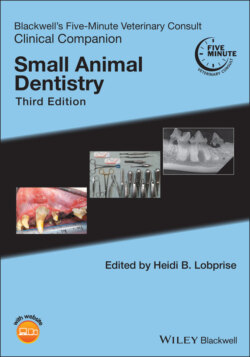Читать книгу Blackwell's Five-Minute Veterinary Consult Clinical Companion - Группа авторов - Страница 26
Identify Tooth Structures
ОглавлениеIdentify normal anatomical tooth structures, noting abnormal as you diagnose each tooth “patient” present. Consider comparing to the same teeth of the opposite side.
Periodontal ligament (PDL) (the black line surrounding the root):A widened PDL can indicate tooth subluxation or periodontal disease, though changes may be subtle.More commonly, a missing or moth‐eaten pattern to the PDL can be noted with replacement tooth resorption (see later bullet point on tooth resorption and Chapter 40).Typical extraction with periodontal ligament elevation may not be possible (Figure 3.32).Evaluate any abnormalities, such as extra roots, abnormally shaped roots (dilacerated), fused roots, or compromised bone (see Chapter 16).
Apex (tip of the root)Extension of disease into the periapical region can cause a “mushroom cloud”‐like lesion as one sign of endodontic (internal tooth) disease (Figure 3.33) (see Chapter 27).Figure 3.32 If there is extensively ankylosis or resorption of the roots, as in this dog’s left maxillary premolars, there is no periodontal ligament left to elevate, so the extraction procedure will be altered.Figure 3.33 Periapical bone loss (halo of osteolucency around an apex) is generally a reliable indication of a periapical abscess due to the loss of the pulp’s vitality. Image shows right mandibular molars in a dog.Do not mistake this for the chevron sign, a possible artifact of healthy teeth.May be a normal PDL thickening of mandibular M1.Contrasting trabecular bone with dense alveolar bone wall is commonly mistaken for a problem in the upper incisors and canines (Figure 3.34). Look for a continuous lamina dura, the white line continuing as if an extension of the PDL.
Pulp width (see Figure 3.34)Teeth age inversely to the way trees do – as the tooth ages, dentin is laid down.Younger patients have wider pulp chambers.Older patients have narrower pulp chambers.Cessation of dentin deposition indicates the tooth has died and is endodontically compromised, requiring root canal therapy or extraction.Compare to the opposite side; look for discoloration (Figure 3.35b).Transilluminate to look for vitality, like candling an egg. Vital tooth transillumination is shown in Figure 3.35a. The right maxillary canine does not transilluminate and is nonvital (Figure 3.35c) (see Chapter 1).Figure 3.34 The pulp width of 104 (right) is wide compared to the same tooth in a dog of a similar age and breed (left). The other sign indicating a nonvital tooth is periapical lucency. A normal chevron sign, as indicated by the presence of the lamina dura, is seen on the healthy tooth.Figure 3.35 Note the pink/purple hue of this dog’s right maxillary canine as compared to the opposite side (b). Transillumination shows a vital tooth (a), whereas the right maxillary canine does not transilluminate and is nonvital (c).The majority (92%) of discolored teeth have pulp necrosis while only 57% show radiographic signs. This means that 43% appear discolored/dull but still have pulp necrosis [10]. Pulp necrosis leads to periodontitis, osteomyelitis and/or systemic infection. These teeth are or will be painful.
Alveolar bone levels surrounding the tooth and the furcation (periodontal disease).Assess the extent:Estimate percent of attachment loss to determine stage of periodontal disease (see Chapter 20).Extensive bone loss may alert you to compromised jaw strength if extractions planned.Assess the pattern of bone loss:Horizontal bone loss: pattern of bone loss across several roots or teeth showing a flattened or scalloped loss; if accompanied by gingival recession, this will result in root and/or furcation exposure (Figure 3.36).Vertical bone loss: pattern of bone loss extending down the axis of a root or roots and often associated with a deep infra‐bony pocket; if this extends to the periapical region, pulp can be compromised. If sufficient bony walls remain, guided tissue regeneration can be performed to return the bone to the height of the lowest bone wall (Figure 3.37).
CrownsWhile not the focus of most intraoral radiographs, noting crown fractures and pulp chamber exposure is important.Endodontic disease is present if the pulp is exposed or the tooth is discolored. The only appropriate treatments are root canal therapy or extraction. As it can take six months [4,7] for enough mineral density change to be evident radiographically, a normal radiograph of an endodontically compromised tooth needs treatment, not watching and waiting.Other signs of endodontic disease, as illustrated in Figure 3.34, are periapical bone loss and a larger pulp chamber.
Figure 3.36 Horizontal bone loss occurs with a linear pattern of bone height loss over several roots or several teeth. Image shows left mandible of a cat.
Figure 3.37 Vertical bone loss down a tooth root often results in deep infra‐bony pockets and can even extend to involve the root’s apex, which would compromise the tooth’s vitality, as shown in the distal root of the right mandibular first molar and mesial root of the second molar of this dog.
